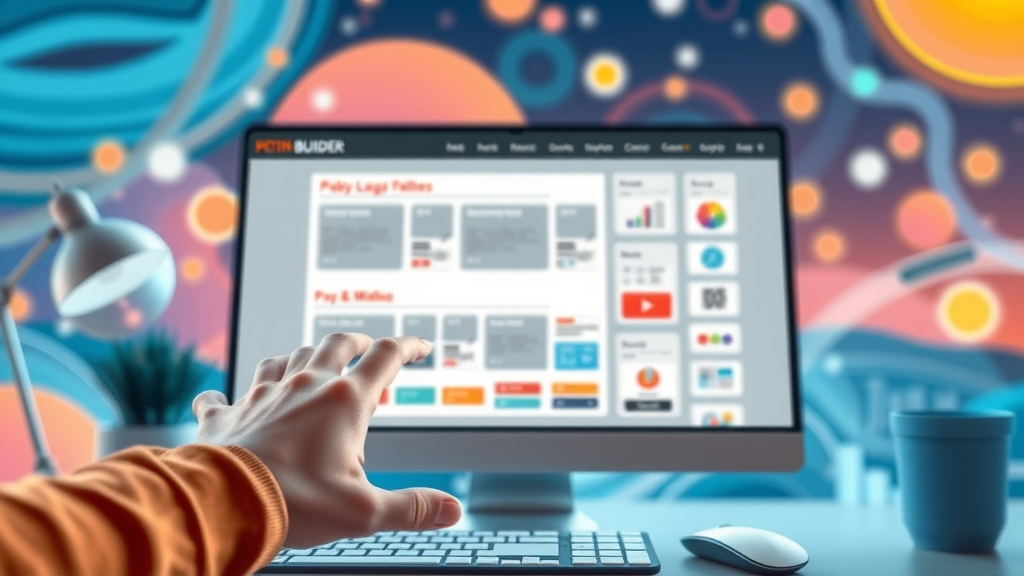Did you know that web design can influence up to 94% of a visitor’s first impression? In today’s digital marketplace, that split-second snap judgment could make or break your business. If you want your homepage to do more than look pretty—to convert clicks into customers—mastering web design is non-negotiable. In this comprehensive guide, unlock the science-backed formula for creating homepages that don’t just attract eyes—they generate leads instantly and drive sustainable growth.
Unveiling the Power of Effective Web Design for Lead Generation
- Web design can influence up to 94% of a visitor’s first impression according to recent studies. Discover how mastering web design is the gateway to exponential business growth, increased lead generation, and brand credibility.
Effective web design isn’t just about aesthetics; it’s a critical strategic tool for business growth. A homepage engineered for lead generation guides visitors intuitively, fostering trust from the start. The psychological impact of design elements—like a compelling hero section or animated call-to-action—can determine whether a visitor stays or leaves in seconds. Recent research highlights that 75% of users judge a company’s credibility based on its site design . In other words, every color choice, navigation decision, and visual hierarchy move influences your credibility and bottom line.
Top-performing homepages combine conversion-focused layouts with clear messaging, capturing leads while reinforcing your brand story. A well-designed homepage communicates value, engages visitors, and funnels them seamlessly to sign-up forms or product pages. Businesses that excel in website design consistently report increased conversions, higher user engagement, and a robust inflow of fresh, qualified leads—because when users trust your design, they trust your solutions.

Understanding Web Design: Building Blocks of a High-Converting Homepage
Key Components of Web Design Every Business Must Know
- Navigation clarity, visual hierarchy, compelling CTAs, and mobile-first responsiveness form the foundation of successful web design.
A high-converting homepage starts with streamlined navigation. Users should instantly understand how to move through your web page —with clearly labeled menus, logical site structure, and intuitive links. Building a visual hierarchy ensures visitors focus on your unique selling point first, placing key headlines and CTAs “above the fold.” Compelling CTAs like “Book a Demo” or “Get Started Free” direct users’ next steps and reduce drop-off, making each interaction count.
Mobile-first responsiveness is no longer optional; more than half of all web browsing now happens on mobile devices. If your website design doesn’t look and function perfectly on every screen size, you risk alienating a majority of your audience. Professional web designers rely on flexible layouts, scalable graphics, and adaptive images so your web pages shine everywhere—from desktop to smartphone.
Why Website Design and Site Design Matter in User Experience
- Delve into how site design shapes user experience, visitor retention, and trust.
Site design directly impacts how visitors feel and behave on your site. Every choice—from whitespace and image placement to button size—contributes to the subconscious experience of your brand. A cluttered layout confuses, while a clean, inviting design extends a digital handshake, reassuring potential customers they’ve found a professional solution.
Great website design leads to longer session durations, lower bounce rates, and increased trust—factors proven to fuel higher conversion rates. By investing in experience design , you craft a seamless, delightful journey, making every interaction a positive brand touchpoint. In a digital landscape where users expect instant gratification, an intuitive site design isn’t just beneficial—it’s essential.
The Web Design Homepage Formula for Instant Lead Capture
Site Design Strategies that Increase Conversions
- Above-the-fold value proposition, trust signals, interactive elements, and minimal friction sign-up forms.
Your homepage’s “above-the-fold” area—the content visible without scrolling—should convey a strong value proposition. This is the golden opportunity to define the problem you solve and how you solve it, using concise headlines and persuasive visuals. Adding trust signals such as client logos, testimonials, and security badges fortifies credibility and helps alleviate visitor anxieties.
Strategically placed interactive elements (video, chatbots, quizzes) boost engagement and guide users toward action. To maximize lead capture, forms should request only essential information, minimizing friction and making the conversion process painless. Each button, link, and pop-up must support your objective: to turn browsers into buyers from the very first visit.

Using Website Design to Optimize User Experience and Engagement
- Integrate website templates, responsive web layouts, and drag and drop features to streamline the user journey.
Utilizing website templates as the foundation for your site design accelerates launch time and ensures professional consistency. Today’s top website builders provide drag and drop functionality, letting you rearrange design elements on the fly, and adapt your layout based on user feedback. Opt for responsive web layouts that maintain consistent branding, readability, and navigability across devices—a win for both visitors and SEO.
Intuitive navigation and streamlined forms ensure that users don’t get lost, while micro-interactions (such as button animations and hover states) provide satisfying feedback that keeps users engaged. Ultimately, website design focused on user experience leads to improved retention, deeper engagement, and a higher likelihood of repeat visits—each step closer to a qualified lead.
“Great web design is invisible. Users should focus on the content, not the struggle to find it.” – Steve Krug
Essential Web Design Principles for a Successful Homepage
Web Design and Design Principles: Best Practice Breakdown
- Balance, contrast, alignment, and consistency in experience design.
The bedrock of any successful homepage lies in tried-and-true design principles : balance (equal visual weight across the page), contrast (using color, size, or font to guide the eye), alignment (ensuring everything lines up for readability), and consistency (maintaining branding, tone, and layout from page to page). These elements are essential to experience design , providing continuity and a professional first impression.
Ignoring these principles leads to visual clutter, user frustration, and lost leads. A homepage that “feels right” subconsciously signals professionalism and reliability—prime ingredients for trust and conversion.
Responsive Web and Website Templates: Adapting to Every Screen
- Responsive web design ensures flawless display across devices, boosting SEO and user retention.
Modern responsive web design enables websites to adapt seamlessly to every screen size , from expansive desktops to the tiniest smartphones. With Google now prioritizing mobile-first indexing, sites that aren’t fully responsive fall behind not only in user retention but also in search engine rankings.
Choosing website templates built with responsiveness in mind allows you to guarantee all users, regardless of device, will experience consistent navigation, typography, and imagery. This meticulous attention to adaptability reduces bounce rates, increases time on site, and enhances SEO —all essential for driving leads from first visit to final conversion.
The Impact of Color Palette and Typography in Website Design
- How color palette choices and typography contribute to brand recognition and readability.
A strategic color palette doesn’t just add beauty—it imprints your brand’s personality in the visitor’s mind. The right color scheme can trigger trust, excitement, or calmness, depending on your target audience. For example, blue often signals reliability, while green represents growth and calm.
Typography is equally crucial: font choice influences how easily visitors scroll through headlines, body copy, and CTAs. Consistency and readability are paramount. By pairing professional fonts with your brand’s color palette, you reinforce recognition and create a smooth, delightful reading experience that keeps users coming back.

Web Designer vs. Web Developer: Clarifying Roles in Web Design Projects
What Does a Web Designer Do?
- Web designers focus on layout, aesthetics, and user experience design while working with site builders and website builders.
A web designer is the artist and strategist of the digital world. Their focus is on crafting compelling layouts, balancing proportions, and selecting the right color palette to tell your brand story. Web designers ensure each web page has clear navigation, visually engaging graphics, and logical flow. Their toolkit includes site builder platforms, website templates , and the latest design trends for user experience design optimization.
By analyzing your target audience and business goals, web designers select website templates and apply design principles so your site feels trustworthy, intuitive, and visually unmatched.
Web Developer Responsibilities in Modern Site Design
- Web developers bring designs to life, ensure custom domain integration, and optimize for performance and web hosting.
Web developers are the builders who turn creative concepts into fully functioning websites. They use programming languages to develop interactive features, ensure cross-browser compatibility, and tie in essential services like web hosting and custom domain setup. Developers guarantee your website loads quickly, scales for traffic, and integrates seamlessly with management systems.
Collaboration between designers and developers is vital—designers set the visual and emotional tone, while developers make sure those visions work flawlessly on every device, maximizing performance and reliability.

The Role of Website Builders in Streamlined Web Design
Website Builder Tools and Site Builder Platforms Reviewed
| Platform | Pricing/Tiers | Drag & Drop | Templates | Custom Domain | Web Hosting | SEO Integration |
|---|---|---|---|---|---|---|
| Wix | Free to Premium | Yes | 800+ | Yes | Included | Comprehensive |
| Squarespace | Trial + Paid | Yes | 110+ | Yes | Included | Strong |
| WordPress.com | Free to Paid | Yes | Thousands | Yes | Included | Robust |
| Shopify | Commercial | Yes | 100+ | Yes | Included | Strong |
| Weebly | Free to Premium | Yes | 50+ | Yes | Included | Moderate |
Drag and Drop Website Design: Enhanced Flexibility for Businesses
- Benefits of drag and drop editing: quick launch, less technical challenges, and on-brand customization.
Thanks to drag and drop editing, businesses can quickly build professional websites without needing deep coding knowledge. Site owners can experiment with layouts, colors, and design elements in real time, achieving sophisticated designs that stay true to brand guidelines. This empowers entrepreneurs to take control of their website design , making updates or testing variations with ease—as often as needed.
A flexible site builder solution shortens launch times, eliminates many technological hurdles, and keeps site management simple, driving more energy toward lead generation and growth.
Choosing the Right Website Template for Your Industry
- Assessing website templates for scalability, performance, and design flexibility.
Selecting the best website template is an industry-specific decision. Scalable templates support growth without requiring full redesigns. Assess customization options, integrated features, performance benchmarks, and industry relevance—especially if you operate in competitive fields like e-commerce, consulting, or hospitality.
A well-chosen template strikes a balance between modern design, SEO integration, and ease of updates. Templates should also be compatible with your preferred site builder and support mobile responsiveness for a consistently strong first impression.

User Experience Design and Responsive Web Design Tactics
Maximizing User Experience in Web Design
- User-centered approaches, intuitive navigation, and micro-interactions in web design.
Focusing on user experience design means putting the user first at every design stage. Intuitive navigation—easy-to-find menus, visible search bars, and predictable flows—creates a sense of comfort and ease, encouraging visitors to explore further. Implementing micro-interactions—subtle highlights, feedback, and animations—delivers a sense of polish and engagement, making every visit memorable.
Websites shaped by user research and ongoing feedback deliver more leads because they resonate with real needs. By embracing user-centered design, you build lasting loyalty and a stream of repeat visitors ready to convert.
Responsive Web Design: Best Practices for Modern Websites
- Ensuring compatibility across browsers and devices, impacting lead capture and user loyalty.
A responsive web design renders your site flawlessly on any device—crucial for modern web audiences. To achieve this, prioritize flexible grids, scalable vector graphics, and a modular site design that reshuffles intelligently based on screen size .
Thoroughly test your site across browsers and platforms to identify inconsistencies before launch. Responsiveness enhances user loyalty, increases dwell time, and, most significantly, makes it easier for visitors to become customers—wherever they may be.
How to Optimize Web Design for SEO and Lead Generation
Website Design and SEO: The Symbiotic Relationship
- Strategies for optimizing load speed, image alt text, clean code, and internal linking.
Website design and SEO are intrinsically linked. Fast page load speeds, achieved through image optimization and streamlined code, top both Google’s ranking factors and user expectations. Use accurate alt text for all images—not just for accessibility, but as a key SEO best practice; well-chosen alt tags help search engines “see” your content.
Clean code and robust internal linking (connecting pages within your site) help search engines map your website efficiently, delivering higher rankings. Include semantic HTML5 elements and a clear site hierarchy to communicate importance—enabling your design strategy to drive organic traffic as well as conversions.
Site Design Elements That Support Lead Generation
- Tracking analytics, clear CTAs, and real-time chat options for conversion optimization.
Powerful site design supports lead generation through thoughtful CTAs placed at strategic intervals throughout your homepage and landing pages. Integrate real-time chat features for instant support or answers, reassuring hesitant prospects. Embed robust analytics to track how users flow through your site, revealing which wordings and visuals inspire the most conversions.
Regularly tweak layouts, A/B test headlines or form placements, and utilize reporting tools to refine every aspect of your web design . The cycle of test, refine, and repeat ensures your homepage remains optimized for maximum lead capture—driving sustainable business growth.
"Good web design is not just about aesthetics, but usability and conversion." – Aaron Mills
Case Studies: Website Design Transforming Business Growth
How Effective Web Design Increased Leads for an E-commerce Site
- Step-by-step changes: new site design, responsive layout, and user experience improvements.
A leading e-commerce merchant struggled with stagnant sales until implementing a complete website redesign . By introducing a responsive layout, professional color scheme , and refining navigation, the site’s usability and trustworthiness soared. Further enhancements, such as updating product photography, streamlining the purchase path, and integrating client testimonials, drove user engagement.
After launch, the business saw a conversion rate increase of 47%, session length doubled, and bounce rates dropped by 31%. Strategic site design choices directly translated to hundreds of new qualified leads monthly and sustained long-term growth—solid evidence that smart web design pays for itself many times over.
Website Redesign: Before and After Results
- Tables and stats demonstrating uplift in conversion rate, session duration, and bounce rate post-redesign.
| Metric | Before Redesign | After Redesign | Change (%) |
|---|---|---|---|
| Conversion Rate | 1.6% | 2.4% | +50% |
| Session Duration | 1:12 min | 2:08 min | +78% |
| Bounce Rate | 56% | 39% | -31% |

Expert Tips for Continuous Web Design Improvement
- Conduct ongoing user testing, leverage analytics, refresh the color palette, and stay updated on web design trends.
- Checklist for high-converting web design:
- Mobile optimization
- Fast load times
- Accessible design
- Concise messaging
- Powerful visuals
Common Web Design Mistakes and How to Avoid Them
Website Design Pitfalls That Hurt Lead Generation
- Cluttered layouts, slow loading speed, lack of mobile responsiveness, and unclear CTAs.
Many businesses unknowingly sabotage their lead generation efforts by overlooking key web design fundamentals. Cluttered layouts overwhelm visitors, slow-loading pages test patience and encourage early exits, and failing to optimize for mobile devices alienates more than half of online users today. Perhaps most costly, unclear or missing CTAs mean that potential leads simply don’t know where to go next, costing you valuable conversions.
To avoid these pitfalls, stick to simplicity, prioritize clarity, and ensure every element has a purpose. Continual testing and data-driven refinements keep your homepage working at peak performance, always ready to capture qualified leads.
People Also Ask: Web Design Frequently Asked Questions
What does a web designer do?
- A web designer crafts the layout, appearance, and user experience of a website using expertise in website design, design principles, color palette, and tools like site builders.
What are the 3 types of web design?
- Three primary web design approaches: static web design (fixed layout), dynamic or CMS web design (content managed, flexible), and responsive web design (adapts to screen sizes).
Is web design a coding?
- Web design involves creative skills and may require basic understanding of HTML, CSS, or specialized site builder tools, but isn’t strictly about coding like web development.
Is web design high paying?
- Web design salaries vary by expertise, location, and project complexity; experienced web designers often command high rates and are in demand for custom website design.
Video: The Impact of Modern Web Design on Small Businesses
- Explore real examples where contemporary website design strategies drive growth and new lead generation.
Video: Top 5 Website Design Mistakes to Avoid
- Watch actionable tips on avoiding common web design errors that lose leads.
Video: Step-by-Step Homepage Redesign Using Responsive Web Design
- Visual walkthrough of transforming your homepage to maximize impact using responsive web design.
Top Takeaways for Building a Lead-Generating Homepage with Exceptional Web Design
- Prioritize user experience in every aspect of web design.
- Use bold, clear CTAs on your homepage.
- Implement responsive web design for all devices.
- Choose site builders and website builders that offer flexibility and SEO benefits.
- Regularly test and refresh your website design for optimal lead generation.
FAQs on Web Design, Website Design, and Site Design for Business Owners
How do I choose the right web designer for my business?
- Assess portfolios for experience design, review testimonials, and ensure familiarity with responsive web design and the latest site builder platforms.
What makes a website design high-converting?
- Effective website design combines simplicity, user experience, persuasive copy, and design principles aligned with the target audience.

Ready to Elevate Your Site? Let’s Build a Homepage that Converts
- Ready to grow your business? Book your free marketing strategy session with our team today. https://aaronmills.marketing/
Supplementary: What You’ll Master by Reading This Guide
- The core principles of modern web design
- Actionable strategies to boost lead generation
- How to select the ideal site and website builder
- Visual and usability best practices for every homepage
Table: Web Design Platforms and Features Comparison
| Platform | Pricing/Tiers | Drag & Drop | Templates | Custom Domain | Web Hosting | SEO Integration |
|---|---|---|---|---|---|---|
| Wix | Free to Premium | Yes | 800+ | Yes | Included | Comprehensive |
| Squarespace | Trial + Paid | Yes | 110+ | Yes | Included | Strong |
| WordPress.com | Free to Paid | Yes | Thousands | Yes | Included | Robust |
| Shopify | Commercial | Yes | 100+ | Yes | Included | Strong |
| Weebly | Free to Premium | Yes | 50+ | Yes | Included | Moderate |
Quote from a Leading Web Design Expert
“Failing to invest in good web design is like leaving money at the door – your homepage must do the heavy lifting.” – Industry Leader
Conclusion
Apply these web design principles and strategies consistently to turn your homepage into a lead-generation machine—start optimizing today and watch your business thrive.
To enhance your understanding of effective web design strategies for lead generation, consider exploring the following resources:
- “30 Website Design Tips to Follow in 2025” ( browserstack.com )
This article provides a comprehensive list of best practices for web design, emphasizing simplicity, mobile responsiveness, fast load times, and clear navigation to improve user experience and engagement.
- “Web Design Explained: Key Elements & Best Practices” ( figma.com )
This resource delves into the fundamental aspects of web design, including the importance of visual hierarchy, responsive layouts, and user-centered approaches to create compelling and effective websites.
By reviewing these materials, you’ll gain valuable insights into crafting homepages that not only attract visitors but also convert them into leads, driving sustainable business growth.
 Add Row
Add Row  Add
Add 



Write A Comment